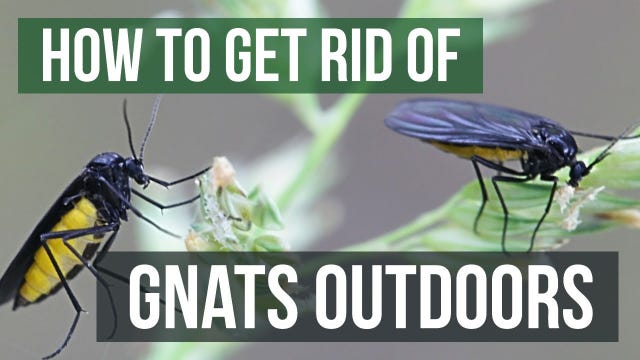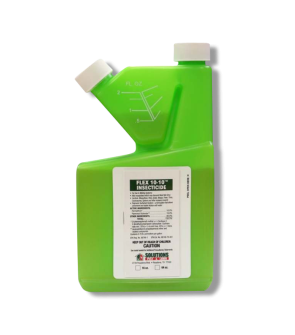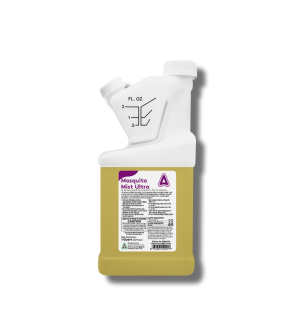Gain access to personalized product screening, the best pricing, rewards, and more!
Most Effective Products
How to Get Rid Of Gnats Outside

This page is an expert guide on removing outdoor gnats using the products and methods suggested by our experienced pest control specialists. Follow this guide and use the recommended products; we guarantee you will eliminate gnats outside your home.
Gnats are annoying pests that can commonly invade a household. However, their peskiness is not limited to indoor potted plants—in fact, they like to attack plants outdoors and are often found infesting our backyards.
Adult gnats can be problematic, but their larvae can be the biggest threat to your plants and grass. As frustrating as it can be to encounter an infestation of gnats outside, they are not invincible. With the help of superior products and expert tips from Solutions Pest & Lawn, you can send these gnats on the run from your backyard.
Identification

It is important to first properly identify the pest you are dealing with as a gnat so you can approach treatment effectively. Misidentification can lead to carrying out the wrong treatment methods, which will cost you time and money.
Gnats are extremely small yet awfully large because of the trouble they cause. They occasionally bite and feed on plant roots. Gnats are often confused with mosquitoes but can be differentiated by their size.
- Gnats usually reach 1/8th of an inch in length, while mosquitoes are double the size at 1/4th of an inch long. Gnat larvae are white or clear-colored and 1/4th of an inch long.
- Gnats have black or brown bodies, six long legs, and long wings.
- Biting gnats will slice through flesh rather than pierce as mosquitoes do.
- Leaving gnats untreated in the house or the yard can be problematic because they don’t take much time to produce larvae and multiply in numbers. Since they are weak fliers, they can linger around even more than flies and mosquitoes do.
- Gnat larvae are usually more of a concern to people than adult gnats because of their potential to damage plants and turfgrass. When there are heavy infestations of gnats, the larvae even end up killing the plants with their relentless feeding habits and tendency to spread diseases.
Gnats should be treated the second they are spotted because if left to their own devices and allowed to grow and feed, they will grow rapidly and begin breeding inside and outside your house.
Inspection

Once you have confirmed that you are dealing with gnats, you need to inspect where they are congregating and how severe of an infestation is present.
Gnats don't show up around your yard or garden without a reason. Often, they have been drawn to your property via a fungal source, moisture, or rotting organic matter since these are prime places for them to lay their eggs.
Where To Look
Check around your yard and garden to see where the gnats are gathering. It could be from a plant with a fungal disease or any damp area drawing them over.
What To Look For
You should look for adult gnats or their larvae. In outdoor settings, fungus gnats may be discovered around dead leaves, rotting firewood, compost piles, and shaded areas with a lot of mulch that may have been excessively watered. Check for mold, fungus, or decaying plants.
Treatment
Getting rid of gnats outdoors is slightly trickier than getting rid of them indoors. Gnats in the garden mean you must resort to measures covering a wider area. A broadcast spray of professional insecticide concentrates is one of the most effective methods.
Once you have confirmed where gnats are gathering, it is time to begin treatment. Remember to read all product labels, follow the application instructions on these labels, and wear personal protective equipment to stay safe.
To get rid of gnats outside, remove moisture around your home and apply a combination of Flex 10-10 Insecticide and Martin's IG Regulator.
Flex 10-10 is a pyrethrin-based insecticide concentrate known for a long residual and quick knockdown of various pests, including gnats. While it's great for killing flying adult gnats, it cannot control the larvae and eggs; that's where Martin's IG Regulator comes in.
Martin's IG Regulator is an IGR (insect growth regulator). An IGR is a chemical that interferes with or hinders the development of insect larvae and eggs so they don't mature into adults. A combination of both these products will result in total control of your gnat problem for up to 7 months.
Step 1: Measure the Treatment Area
Before applying the pesticides, you will need to figure out how much product you will need.
Measure the square footage of the treatment area. Do this by measuring the treatment areas' length and width in feet, then multiply them together (length X width = square footage).
To treat gnats, 6.4 oz of Flex 10-10 is suggested per gallon of water to treat 1,000 square feet of surface.
For Martin's IG Regulator, 1 fl. oz. per gallon of water is suggested to treat 1,000 square feet.
Step 2: Mix The Flex 10-10 and Martin's IG Regulator
In a handheld pump gallon sprayer, fill it halfway with water and then mix in the appropriate measured amount of Flex 10-10 and Martin's IG Regulator based on your calculations. Fill the sprayer with the remaining half of water and shake well.
Once the product is well mixed, you can broadcast the spray as a light mist (via fan spray setting) over all the plants and the soil.
Pump the sprayer a few times to create a low-pressure spray, and you will be ready to apply.
Step 3: Spray Areas with The Flex 10-10/Martin's IGR Solution
Once the product is well mixed, you can broadcast spray a light mist (via fan spray setting) over all the infested plants and in the soil.
Coat the plants with the solution until wet, but be careful not to spray them to the point of runoff. Be sure to treat bushes and trees around the sites where there is excessive moisture.
Wait a few days and then check for gnat activity. Apply as needed in 2 to 4-week intervals as needed until the gnats are gone.
Alternatively, you can apply Flex 10-10 using an Automatic Misting System. Apply at a 1:100 dilution ratio of product to water.
In high pest-pressure situations, you can use a 1:55 dilution ratio. A properly calibrated misting system must not apply more than the max daily rate of 0.09 fl. oz. per 1,000 cubic feet.
Prevention
Once the gnats on your property have been eradicated and the damage has ceased, you need to ensure they don't return. To do this, you need to take preventative measures.
- When you water your lawn, water 1 to 1.5 inches once per week. Once your plants are watered, make sure the soil is completely dry with no remains of logged water. The less moisture there is, the more chances there are of gnats deteriorating. Amending the garden soil will also improve drainage. Most importantly, change the water in the birdbaths and other containers daily.
- Whenever you trim your garden, collect all the fallen leaves and throw them away as soon as possible. Also, all decaying organic materials, dead plants, and leaves in the garden should be removed. Trash cans near your house should be kept covered at all times, and as soon as they are filled, throw the garbage and cover it with clean garbage bags.
- Finally, conduct Flex 10-10 and Martin's IG Regulator treatments every 2 to 4 weeks as needed until there is no further gnat activity.
Key Takeaways
Why Are Gnats Bad
- Gnats can become a problem in the yard and garden when fungal disease develops, rotting organic matter occurs, or there is excess moisture.
How to Get Rid of Gnats Outside
- Applying a combination of Flex 10-10 and Pivot 10 IGR can kill fungus gnats in all stages and keep them off your property.
How to Prevent Gnats Outside
- Prevent gnat invasions by keeping your yard and garden neat and clean and addressing moisture problems.
-
Q:Is this product pet safe outdoors? Does it have to be reapplied after each rain? Does it kill beneficial insects like bees and butterflies? Does it harm wooden or stain decks? Patio furniture?4/7/24A:Yes, these products are pet safe when applied according to label directions and applications have completely dried. You will not need to reapply after each rain if the application has had a chance to completely dry before rainfall. These products are toxic to bees exposed to direct treatment on blooming crops or weeds. Do not apply this product or allow it to drift to blooming crops or weeds while bees are actively visiting the treatment area. Finally, these products are Emulsifiable Concentrates (EC) and are formulated with solvents that may damage or stain surfaces, such as vinyl. If it is nude wood then you should not see any damage or staining, but keep in mind that ECs like these may be less effective on wood surfaces because they actually seep into the porous surface, making it less effective on contact.
Colin
4/18/24












